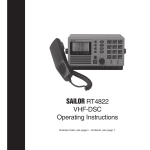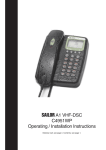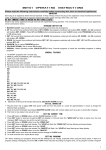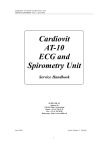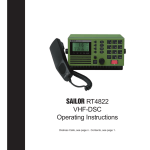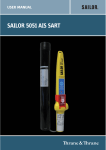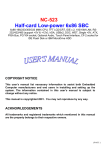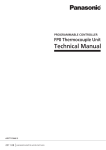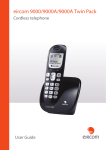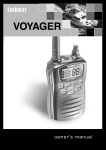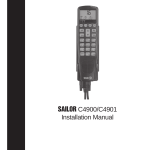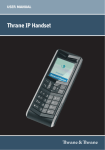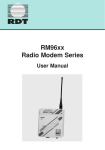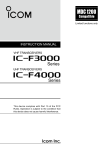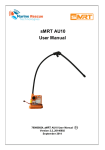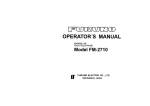Download User Manual - Polaris Electronics A/S
Transcript
SAILOR A1 Basic VHF Operating Instructions Distress Call, see page ii. Contents, see page 1. DISTRESS Call 1. If off or UNIT OFF: press ON/OFF. 2. Hook off the handset. 3. To enter VHF mode on CH 16 press 16 MEM VOL SQ 1 10 03 Press Pressing PTT, say: “MAYDAY” “This is” - the 9-digit identity and the call sign or other identification of the ship, - The ship’s position, - The nature of distress and assistance wanted, - any other information which might facilitate the rescue. “OVER.” Release ii Release PTT and listen for answer. Handset What is What? 1 2 3 4 7 8 9 10 11 18 5 6 12 19 13 14 15 16 17 Abbreviations Used in this Manual 1. Display 2. Indicator lamps TX 1W US 3. TX power level 4. INT/US (for information on the BI version, see page 7.) 5. Dimmer 6. Speaker ON/OFF 7. Channel selection 8. Shift key 9. 10. 11. 12. 13. 14. 15. 16. 17. 18. 19. FUNC key ON/OFF button Earpiece Volume control Squelch selection Intercom Channel 16 quick select Loudspeaker Microphone PTT key 25W key (US versions only) ADDR ATIS BI CU DSC DUP DW GMDSS GPS LF MEM MMSI MSG PTT RX SQ STN TEL TX UTC Address Automatic Transmitter Identification System Channel Mode used when sailing on European rivers (details on p. 7) Control Unit Digital Selective Calling Duplex Dual Watch Global Maritime Distress and Safety System Global Positioning System Low Frequency Memory Maritime Mobile Service Identity Message Push-To-Talk (talk button) Receive(r) Squelch Station Telephony Transmit(ter) Coordinated Universal Time iii Introduction About this Manual For more than half a century, Sailor has been synonymous with highquality maritime communication equipment. This manual is for the daily user of the system. The manual includes two main sections, “basic” operation and “full” operation. The basic part offers a short easily-read description of the main functions; the full part offers elaborate descriptions of the functions of the product. When it comes to making use of the very latest technology, S. P. Radio is at the forefront. We are ready for the future, both technologically and commercially, and will continue to supply top-quality equipment for global communication in the years to come. S. P. Radio’s experience in maritime safety and communication is extensive; the company has built as many as 250,000 VHF units, mainly for the professional market. One of the main reasons for this huge success is continual product development, which makes it possible for us to offer products that are truly excellent in terms of quality, sturdiness, ease of operation, and compact design. Please note Any responsibility or liability for loss or damage in connection with the use of this product and the accompanying documentation is disclaimed. The information in this manual is furnished for informational use only, is subject to change without notice, may contain errors or inaccuracies, and represents no commitment whatsoever. This agreement is governed by the laws of Denmark. Doc. No.: B4900GB0 The SAILOR A1 Basic and A1 DSC are part of the new SAILOR System 4000. This is a full range of maritime communication equipment developed to increase safety and ease communication for all kinds of vessels: leisure boats, fishing vessels, cargo ships, and cruise liners. As our central concern is fast and professional service, we have introduced the SAILOR Certified Service Centre (CSC) concept. This, we feel, is the ultimate way of ensuring a high level of service, continuously monitored and adjusted. Today S. P. Radio is the leading VHF supplier in the world, represented in 90 countries around the world. Consequently we are able to service your SAILOR VHF equipment in the best way possible. No matter where. iv Issue: H/0139 Contents DISTRESS Call ..................................................................... ii Handset ................................................................................ iii What is What? .................................................................. iii Abbreviations Used in this Manual .................................. iii Introduction ......................................................................... iv About this Manual .............................................................. iv Telephony Display ............................................................... 2 Handset Main Function Keys ............................................. 2 Basic Operation ................................................................... 3 Switching ON/OFF ........................................................... 3 Basic Telephony Operation ................................................ 3 Listening for Telephony Calls ........................................... 3 Receiving a Telephony Call ............................................. 4 Making a Telephony Call .................................................. 4 Channel Control ............................................................... 5 Squelch Control ............................................................... 5 Setting the Volume Level ................................................. 6 Muting the Speaker .......................................................... 6 Setting Transmitter Power Level ...................................... 6 Dimmer Function .............................................................. 6 Full Operation ...................................................................... 7 Full VHF Telephony Operation ........................................... 7 Setting Channel Mode ..................................................... 7 Setting International/US Channel Mode .......................... 7 Setting International/BI Channel Mode ............................ 7 25W Transmitter Power Level ......................................... 7 Setting Memory Scan Table ............................................. 8 Scanning of Channels ...................................................... 8 Dual Watch ..................................................................... 10 Keyboard Lock ................................................................ 11 Intercom .......................................................................... 11 Function Menu ................................................................... 13 Function Menu Item Description .................................... 15 FUNCtion Menu Tree ..................................................... 17 VHF System Description ................................................ 18 International Channels ...................................................... 19 US Channels ....................................................................... 20 BI Channels ........................................................................ 21 1 Telephony Display Handset Main Function Keys Normal display ON/OFF key. Turns the handset on or off. “16” key. Selects TELEPHONY mode and channel 16. Scanning display Function menu. Enters the function menu to set up the handset and system. If function menu is active it enters VHF telephony mode. After 5 minutes of inactivity the handset will resume in telephony mode by default. 2 Basic Operation Switching ON/OFF Listening for Telephony Calls According to international rules, all ships shall monitor channel 16 constantly: 1. Select channel 16 by pressing: 16 MEM VOL SQ 1 10 03 2. Set the squelch level by means of the buttons To switch on the handset unit, push the ON/OFF button on the handset. If the handset unit is off, the display is blank or shows “UNIT OFF” to indicate that the system is operated from another control unit. To switch off the handset unit, push the ON/OFF button on the handset for at least 1 second. Basic Telephony Operation To activate the VHF functions if not active press the key “16”. a. Step down squelch level until noise is heard on free channel. b. Then step up to the first level where just silent. (To listen for calls on other channels, select the channel number or use the scanning facility.) 3 Receiving a Telephony Call Making a Telephony Call When a call comes in, and your call name is heard in the loudspeaker: In telephony mode: 1. Hook off the handset. 74 Press MEM VOL SQ 1 08 02 2. Press the PTT key on the handset. 1. Select channel 16 or another channel specified or agreed upon: 3. To answer the call, say: “<The name of the calling station> This is <Your station name>“ 2. Hook off the handset. 4. To suggest channel, say: “Channel <suggested channel number>” 5. Say “over” and release the PTT key to let the caller accept the proposed channel number. Release 3. When speaking, press the handset PTT key. Press 6. Switch to the channel agreed upon (for example channel 71) and communicate: 71 MEM VOL SQ 0 10 03 For short-distance communication, use 1W. Make the call: 1. <Called station name (3 times)> 2. “This is “ <Your station name (3 times)> 3. “Over” 4. Release the PTT key to listen. Release Press the PTT key when talking only. If on a simplex channel, say “over” every time you have completed talking. 5. When answered, agree upon a channel, switch to the channel (for example channel 6) and communicate. 6 MEM VOL SQ 1 08 02 Press the PTT key when talking only. If on a simplex channel, say “over” every time you have completed talking. 4 Channel Control Setting the VHF channel can be done in three ways by means of the numeric input keys (sequentially) or by means of the function “next channel up/down”, or by using the quick select key “16”: Numeric keys: Press the numeric input keys (sequentially) until the desired channel number is shown on the handset display: The next channel function is active until the key is released again, toggling through the channels as long as pushed. Quick select key: Press the key 16 . MEM VOL SQ 1 10 03 Squelch Control Manual squelch level setting: Set the squelch sensitivity of the receiver by buttons Ex: 71 MEM VOL 6 SQ MEM 0 10 03 VOL SQ 1 08 02 If private channels are available in your VHF system, a private channel number is selected by pushing the buttons: Ex: Private channel 23 Press up/down automatically. P23 MEM VOL for more than 4 seconds and the squelch level goes The squelch setting is shown on the display below the “SQ” symbol. SQ 0 09 01 Next channel function: To select the next channel up or down (starting point is displayed channel). 71 Push MEM VOL Automatic squelch level setting: The VHF system automatically sets the optimal squelch level to mute the background noise level. To set squelch level automatically: Press SQ 0 09 01 5 Setting the Volume Level Setting Transmitter Power Level Setting the volume level can be done both for the speaker and the earpiece individually. (The setting can be 0-15). The volume level of the speaker can be controlled when handset is on hook, or the speaker is set to be active when handset is hooked off. The volume level of the earpiece can be controlled when the handset is hooked off, and the speaker is not set to be active when handset is hooked off. The volume setting for the earpiece can also be set in the function menu. If the speaker is active the speaker setting is always shown on the display. Only when the handset is hooked off and the speaker is not set to be active, is the volume level of the earpiece shown. The handset can control the transmitter power level, which can be set to either 1W or 25W. Low power 1W is indicated by the indicator lamp on the display. Some channels may be programmed to operate at 1W level only. . To change the TX power level press 16 To change the volume setting use MEM VOL SQ 1 08 04 6 the key MEM VOL 1W indicator lamp SQ 1 10 01 Press the key for more than 1 second and the volume level goes up/ down automatically (until the volume limit is reached). Muting the Speaker Dimmer Function If the speaker is active the handset automatically mutes the speaker when the PTT is pressed, and then reactivates the speaker when the PTT is released. The handset features display backlight, keyboard backlight and light in the indicator lamps (TX, 1W, US). The light can be set at four steps 0-3. The speaker icon on the display shows the speaker state. To change the dimmer level: Speaker active: Press To mute the speaker, press: 6 MEM VOL SQ 1 08 04 Speaker muted: To reactivate the speaker, press: 6 MEM VOL SQ 1 08 04 6 6 LEVEL 2 When the key is being pressed the dimmer level will change every second. Full Operation Full VHF Telephony Operation Setting Channel Mode 25W Transmitter Power Level Some VHF radios offer a choice between two sets of channels, called channel modes. If your VHF features two modes, you can either switch between international/US channels, or between international/BI channels. NB! For US channels 13 and 67. If the VHF is programmed with the set of US channels, some of those channels are specified to be used only with the limited transmitter power level of 1W. This means that the TX power level cannot be changed to 25W as described. International mode is used when sailing on any sea in the world, except in US waters. US mode is used when sailing in US waters. BI mode is used when sailing on the rivers of Europe. Setting International/US Channel Mode If your VHF features the choice of international/US mode, switching between those two sets of channels is done by pressing the key: However, it is still possible to set the TX power level to 25W by using: The TX power level of 25W is only active while the key is being pressed down; when the key is released the TX power level is again reduced to 1W. 6 MEM VOL SQ 1 08 01 Channel mode indication When US mode is selected, the yellow US indicator lamp is lit. Otherwise, the radio is in international mode. Setting International/BI Channel Mode If your VHF features the choice of international/BI mode, switching between those two sets of channels is done by pressing the key: 6 MEM VOL SQ 1 08 01 Channel mode indication When BI mode is selected, the yellow BI indicator lamp is lit. Otherwise, the radio is in international mode. When BI mode is selected, ATIS is activated automatically. 7 Setting Memory Scan Table Scanning of Channels The VHF 4000 system has eight independent sets of memory tables to save channels for making scanning sessions. Each memory table may contain all channels available in the system. To distinguish between the tables, each table has a number (0-7) and to each number can be attached a name of maximum seven characters. To attach a name to a scan table, enter the function menu. The scan table number selected is shown in the left corner of the handset display. 6 MEM VOL SQ 7 09 01 Pre-programmed memory tables for scanning of channels: Table 6: Channels for intership communication. Table 7: All channels in system. To start scanning: Press Pr MEM P-CH 7 ALL 16 The lower part of the display shows from left to right: scan table number, scan table name, priority channel of scan table. If scan table contains no channels, no scanning will be started, and the display will show the following message: MEM EMPTY It is recommended not to alter the pre-programmed channels in scanning tables 6 and 7. These scanning tables are used to search for channels for intership DSC communication, and altering the channels may exclude you from performing intership communication on certain channels. To stop scanning: Scanning in progress can be terminated in the following ways: 1. Press Setting the selected scan table: To set the selected scan table to be number 0: The system resumes normal VHF operation on the channel selected before the scanning session was initiated. SEL 1. Press 2. Press MEM The system resumes normal VHF operation on quick select channel “16”. 7 ALL The handset display shows the message “SEL”ect and the MEM symbol flashes. The lower part of the display shows the scan table’s number and name. 3. Hook off the handset. The system resumes normal VHF operation on the channel selected before the scanning session was initiated. 4. Push the PTT 6 2. Press MEM The display now shows the new scan table number 0. 8 VOL SQ 0 09 01 If no signal has been detected on any channel, the system resumes normal VHF operation on the channel selected before the scanning session was initiated. If a signal has been detected on a channel, the system resumes normal VHF on the last channel where signal was detected. If scanning is in progress and a signal is detected on eg. channel 6, the display changes to show the selected channel number and volume level. When a priority scanning is in progress, channel 16 is scanned once for every channel scanned in the scan table. Channel 16 cannot be deleted or excluded while a scanning is in progress. 6 MEM VOL 7 09 To delete a channel from a scan table: Select channel number (shown on the display), and then press Ex: To delete channel 6 from scan table number 1: 6 1. Press P-CH 16 Channel 6 is selected. MEM VOL SQ 1 08 04 To add a channel to a scan table: Select channel number (shown on the display), and then press 6 2. Press The message “delete channel” is shown for one second. DELETE CH Ex: To add channel 6 to scan table number 1: 1. Press 6 Channel 6 is selected. MEM VOL Then the display will show the next channel in the scan table. The message “stores channel” is shown for two seconds. VOL SQ 1 09 01 SQ 6 7 MEM 1 08 04 2. Press DUP If there are no more channels in the scan table and deletion is attempted, the display will show the message “mem empty”. MEM EMPTY STORES CH 9 To view contents of channels in a scan table: Viewing which channels a specific scan table contains, can be done in two ways: While the key is being pressed down, the display will step through the channels of the scan table selected. 1. Press , the latter for 1 second. Dual Watch The handset may perform a dual watch of channels, a priority channel and the selected channel being monitored simultaneously. To start a dual watch with channel 6 and priority channel 16: Select channel 6. Then press OR 6 DW 2. Press , the latter for 1 second. 12 MEM 7 CONTENT When a dual watch is in progress, “DW” appears in the top left corner of the display and the priority channel is shown in the bottom right corner of the display. MEM VOL P-CH 1 08 16 To stop a dual watch: When a dual watch is in progress it can be terminated in three ways. 1. Press 2. Push PTT 6 MEM VOL SQ 1 08 04 The system resumes VHF on the selected channel 6 and starts transmitting. 16 3. Push MEM VOL SQ 1 08 04 The system resumes VHF on the quick select channel (normally 16). 10 Keyboard Lock Intercom The handset has a keyboard lock, which locks some keys to avoid unintentional channel changes during a telephony session. When the keyboard is locked the only functions that can be controlled are: If your VHF system has more than one control unit, it is possible to carry out an intercom between two control units. When the intercom feature is used the handset will perform as follows: 1. Setting the volume level. 2. Setting the squelch level. 3. Channel up/down. Initiating an intercom from the handset to another control unit: To call another control unit: IC 1. Press SELECT NO To lock the keyboard: Press (second time, press for 1 second). 6 MEM VOL This display indicates that the handset expects an input of the location number to be called. 2. Press a numeric key to choose location to be called SQ 1 08 04 The key symbol appears, indicating that the keyboard is locked. Unlocking the keyboard can be done in two ways: 6 1. Press MEM The keyboard is unlocked. VOL Ex: SQ 1 08 04 3. If location 2 is NOT available, the display shows 2. Press 16 for 1 second. The keyboard is unlocked and channel 16 selected. MEM VOL and no dialling is carried out. SQ IC2 NOT AVAIL 1 08 04 If location 2 is available the display shows and a ringing tone is heard in the speaker/earpiece. IC2 CALLING 11 This indicates that a dial-up is in progress to the control unit with location number 2. The lower part of the display now toggles the message CALLING and the NAME of the called control unit. During the dialling time of 30 seconds it is possible to hook off the handset and speak into the microphone. As LF is activated in the called control unit during dialling, the receiver of the call can hear you in the speaker without hooking off. This makes it possible to use the VHF system as a sort of paging system. 4. If the intercom attempt is answered: When the receiver of the call hooks off his handset, the intercom is established. IC2 During intercom the handset is able to: “NAME” If the intercom attempt is not answered: If the receiver of the call does not answer the intercom within 30 seconds, the handset automatically hangs up and reenters normal VHF operation. 1. Adjust volume level 16 MEM VOL SQ 1 10 03 Receiving an intercom attempt from another control unit: When an intercom is attempted from another control unit to the handset, this will act as illustrated in the following example, where the caller has location number 3. 1. Receiving an intercom The display toggles CALLING and the NAME of the caller. A ringing tone is heard in the speaker. IC3 CALLING 2. To answer the intercom, hook off handset. 2. Mute/unmute speaker 3. Adjust squelch level 4. Adjust dimmer level Terminating an intercom session: The intercom connection can be terminated by either of the control units. To end an intercom: 1. Place handset on hook. The handset resumes in VHF mode. 2. Key The handset resumes in VHF mode. The intercom connection between the two control units is now established; to communicate, simply press PTT and speak into the microphone. 12 3. Key The handset resumes in VHF mode selecting channel “16”. 4. Function Menu The function menu offers facilities to view and set up the functionality of the handset unit. It also offers facilities to view and change functionality of the VHF transceiver and of the DSC modem as well. To enter the function menu. To view or set any specific items in the function menu press the keys ___ FUNC a. To enter an alphanumeric character in the cursor’s place. TELEPHONY To move around in the function menu use the keys: 1. : To set menu entry to be entered. To leave the function menu: NB: If any setting has been changed when leaving the function menu, the handset has to be turned off and then on again for the changes to take effect. The function menu can be left in the following ways: 2. : To enter the entry set in 1. 3. : To reenter the function menu (press for 1 second). 1. : Activates VHF mode, selecting channel 16 16 MEM VOL SQ 1 08 04 To edit items in the function menu, use the keys: 2. 1. : a. To change option “Y”/“N”. b. To change single numeric value, up or downwards until limit. 2. : a. To save/select item setting, entering the next item too. b. To move one step to the right in an item with more inputs. 3. : a. To reenter the function menu (press for 1 second). b. To delete the character to the left of the cursor (moving one step to the left in an item). : Activates VHF mode 13 Example: To activate keyboard “beep” function for keyboard to beep every time a key is pressed. 1. : Enters the function menu 2. : ___ FUNC ___ FUNC Pushed twice, finds the general entry : Enters the entry : Finds the entry 4. ___ FUNC ILLUMIN ___ FUNC SOUND 5. : Enters the sound entry ___ FUNC EARPIECE 6. : Pushed twice, finds the entry 7. : Enters keyboard entry ___ FUNC KEYBOARD ___ SELECT FUNC KB.BEEP N 14 FUNC 8. : Edits item Y(es)/N(o) KB.BEEP Y TELEPHONY GENERAL 3. SELECT When Y(es)... 9. : Selects the setting and reenters the function menu ___ FUNC TELEPHONY To activate the new settings, turn the handset off and then on again. Function Menu Item Description Path: Data: GENERAL\ILLUMIN\INDICATOR\LEVL_0-3 0-3 GENERAL\ILLUMIN\DISPLAY\DB_L_0-3 0-9 GENERAL\ILLUMIN\DIMMER\D_LEVL 0-3 GENERAL\ILLUMIN\DIMMER\D_LEVL\DIMDIR 0-2 GENERAL\ILLUMIN\KEYB0ARD\SECS 0-20 GENERAL\ILLUMIN\KEYB0ARD\SECS\D_LEVL 0-3 GENERAL\SOUND\EARPIECE\NORM 0-15 GENERAL\SOUND\EARPIECE\NORM\ALARM 0-15 GENERAL\SOUND\LOUDSPEAK\NORM 0-15 GENERAL\SOUND\LOUDSPEAK\NORM\ALARM 0-15 GENERAL\SOUND\LOUDSPEAK\NORM\ALARM \EXT_SPK 0-3 GENERAL\SOUND\LOUDSPEAK\NORM\ALARM \EXT_SPK\HO_SPK 0-1 GENERAL\SOUND\KEYB0ARD\KBBEEP GENERAL\SOUND\SIDETONE\ST ATT SERVICE\TELEPHONY\CH+MODE\INPUTS Description: Light intensity of each indicator lamp dimmer level. Light intensity of each display backlight dimmer level. Dimmer level when handset is turned on. Dimmer level start direction (see diagram on next page). Number of seconds that handset light is on after a key has been pushed. Dimmer level when any key has been pushed (provided number of seconds in item above is 1 or more) Earpiece normal volume level when handset is turned on. Earpiece alarm volume level when receiving DSC call or intercom. Speaker normal volume level when handset is turned on. Speaker alarm volume level when receiving DSC call or intercom. Handset control of external speaker. Speaker state when handset is hooked off. Default on=1 or off=0. "Y"/"N" Keyboard key beep when pushing key. Feedback level of microphone to earpiece 0-3 (recommended setting=1). Setup of number of input digits when changing VHF channel. "Y"/"N" Y = 3 digits, N = 2 digits 15 The dimmer start direction can be set up in three different ways: Start direction 0: Start direction 1: Start direction 2: 16 FUNCtion Menu Tree Telephony | | | General | | | | | | | | | | | | | Service Scanner Squelch Atis no Mem-no X Name XXX Mode X XXXXXXXXX Pr-ch XX Pr_sc X Illumin | | | | Sound | | | | | Version Indicator Display Dimmer Keyboard Levl_0 X Levl_0 X D_levl X Secs XX Levl_1 X Levl_1 X D_dir X D_levl X Levl_2 X Levl_2 X Levl_3 X Levl_3 X Earpiece Loudspeak Keyboard Sidetone Norm XX Norm XX Beep X St att X Alarm XX Alarm XX Extspk X Ho spk X Handset Transceiv Software Software XXXXXX XXXXXX Serial no Serial no XXXXXXXX XXXXXXXX Code XXX Bus setup Telephony Handset Ch_Mode Loc_No X Inputs X Name XXX 17 VHF System Description To the VHF system can be connected up to 7 control units. Each control unit has a unique location (1-7). If a control unit wants to control the transceiver, it has to be master of the system. The following describes the display read-outs shown in connection with different system priorities of the control units: The control unit assigned location number 1 has the highest priority in the VHF system and is able to become master of the system at any time needed. When more control units are connected to the VHF system, the main control unit has to be assigned location number 1. When the system is free: If a handset is in VHF mode, the display will show. 6 MEM VOL SQ 1 08 02 If a handset’s function menu is active, the display shows the menu item. ___ When a control unit is master of the system, the other control units, if in VHF mode, show the following display to indicate that the transceiver is in use by another control unit: oCC 1 BRIDGE The control unit location name The control unit location number If the other control units’ function menus are active, the display will show the menu item as usual. ___ TELEPHONY Getting the MASTER priority in the system: To operate the transmitter, the handset has to be master of the system. To become master of the system, simply hook off the handset. When the handset becomes master of the system, the display will not change. TELEPHONY If the handset does not become master of the system and the handset is operated in VHF mode, the display will show the message: oCC 1 BRIDGE If the system is occupied by another control unit, hang up and wait for the system to become free. 18 International Channels &KDQQHOV 1 2 3 4 5 6 7 8 9 10 11 12 13 14 15 16 17 18 19 20 21 22 23 24 25 26 27 28 7; 0+] 156,050 156,100 156,150 156,200 156,250 156,300 156,350 156,400 156,450 156,500 156,550 156,600 156,650 156,700 156,750 156,800 156,850 156,900 156,950 157,000 157,050 157,100 157,150 157,200 157,250 157,300 157,350 157,400 5; 6,03/(; '83/(; 0+] ,QWHUVKLS 3RUW 3RUW 3XEOLF 160,650 160,700 160,750 160,800 160,850 156,300 160,950 156,400 156,450 156,500 156,550 156,600 156,650 156,700 156,750 156,800 'LVWUHVVDQGFDOOLQJ 156,850 161,500 161,550 161,600 161,650 161,700 161,750 161,800 161,850 161,900 161,950 162,000 &KDQQHOV 60 61 62 63 64 65 66 67 68 69 70 71 72 73 74 75 76 77 78 79 80 81 82 83 84 85 86 87 88 7; 0+] 156,025 156,075 156,125 156,175 156,225 156,275 156,325 156,375 156,425 156,475 156,525 156,575 156,625 156,675 156,725 156,775 156,825 156,875 156,925 156,975 157,025 157,075 157,125 157,175 157,225 157,275 157,325 157,375 157,425 5; 6,03/(; '83/(; 0+] ,QWHUVKLS 3RUW 3RUW 3XEOLF 160,625 160,675 160,725 160,775 160,825 160,875 160,925 156,375 156,425 156,475 156,525 '6& '6& 156,575 156,625 156,675 156,725 156,775 / 156,825 / 156,875 161,525 161,575 161,625 161,675 161,725 161,775 161,825 161,875 161,925 157,375 157,425 Notes: L) *) NB! 1 W TX power. Due to the introduction of the channels AIS1 at 161.975 MHz and AIS2 at 162.025 MHz for Automatic Identification System, channels 87 and 88 became simplex channels as of 1 January. The RX and TX frequencies can be read out on the control unit handset display by pressing (for more than one second) and holding the CH key. At a front-operated VHF radio, the RX and TX frequencies can be displayed on a menu. 19 US Channels &KDQQHOV 1 2 3 4 5 6 7 8 9 10 11 12 13 14 15 16 17 18 19 20 21 22 23 24 25 26 27 28 7; 5; 6,03/(; 0+] 0+] 156,050 156,050 '83/(; % 156,150 156,150 % 156,250 156,300 156,350 156,400 156,450 156,500 156,550 156,600 156,650 156,700 156,800 156,850 156,900 156,950 157,000 157,050 157,100 157,150 157,200 157,250 157,300 157,350 157,400 156,250 156,300 156,350 156,400 156,450 156,500 156,550 156,600 156,650 / 156,700 156,750 5; 156,800 'LVWUHVVDQGFDOOLQJ 156,850 156,900 156,950 157,000 157,050 157,100 157,150 161,800 161,850 161,900 161,950 162,000 &KDQQHOV 60 61 62 63 64 65 66 67 68 69 70 71 72 73 74 75 76 77 78 79 80 81 82 83 84 85 86 87 88 7; 0+] B) !) RX) NB! 20 6,03/(; '83/(; &KDQQHOV % P1 P2 P3 P4 P5 P6 P7 P8 P9 P10 156,075 156,075 % 156,175 156,225 156,275 156,325 156,375 156,425 156,475 156,525 156,575 156,625 156,675 156,725 156,175 156,225 156,275 156,325 156,375 156,425 156,475 156,525 156,575 156,625 156,675 156,725 / '6& % % 156,875 156,925 156,975 157,025 157,075 157,125 157,175 157,225 157,275 157,325 157,375 157,425 Notes: L) 5; 0+] 1 W TX power. By pressing the 25W button in the US hook, the transmitter will transmit at 25W on channel 13 and 67, which are normally limited to 1W transmission. Channels 2, 4, 60, 62, 75 and 76 cannot be selected in US mode. Channels 3, 21, 23, 61, 64, 81, 82 and 83 may be legally used in certain instances, but they are not for use by the general public in US waters. Only RX. Transmitter is blocked. The RX and TX frequencies can be read out on the control unit handset display by pressing (for more than one second) and holding the CH key. At a front-operated VHF radio, the RX and TX frequencies can be displayed on a menu. 156,875 156,925 156,975 157,025 157,075 157,125 157,175 161,825 161,875 161,925 161,975 157,425 / :; WX1 WX2 WX3 WX4 WX5 WX6 WX7 WX8 WX9 WX10 5; 0+] 162,550 162,400 162,475 162,425 162,450 162,500 162,525 161,650 161,775 163,275 BI Channels &KDQQHOV 1 2 3 4 5 6 7 8 9 10 11 12 13 14 15 16 17 18 19 20 21 22 23 24 25 26 27 28 7; 0+] 156,050 156,100 156,150 156,200 156,250 156,300 156,350 156,400 156,450 156,500 156,550 156,600 156,650 156,700 156,750 156,800 156,850 156,900 156,950 157,000 157,050 157,100 157,150 157,200 157,250 157,300 157,350 157,400 5; 6,03/(; '83/(; 0+] ,QWHUVKLS 3RUW 3RUW 3XEOLF 160,650 160,700 160,750 160,800 160,850 156,300 / 160,950 156,400 / 156,450 156,500 / / 156,550 / 156,600 / 156,650 / / 156,700 / 156,750 / / 156,800 'LVWUHVVDQGFDOOLQJ 156,850 / / 161,500 161,550 161,600 161,650 161,700 161,750 161,800 161,850 161,900 161,950 162,000 &KDQQHOV 60 61 62 63 64 65 66 67 68 69 70 71 72 73 74 75 76 77 78 79 80 81 82 83 84 85 86 87 88 7; 0+] 156,025 156,075 156,125 156,175 156,225 156,275 156,325 156,375 156,425 156,475 156,525 156,575 156,625 156,675 156,725 156,775 156,825 156,875 156,925 156,975 157,025 157,075 157,125 157,175 157,225 157,275 157,325 157,375 157,425 5; 6,03/(; '83/(; 0+] ,QWHUVKLS 3RUW 3RUW 3XEOLF 160,625 160,675 160,725 160,775 160,825 160,875 160,925 156,375 156,425 156,475 156,525 '6& '6& 156,575 / 156,625 / 156,675 156,725 / 156,775 % 156,825 % 156,875 / 161,525 161,575 161,625 161,675 161,725 161,775 161,825 161,875 161,925 157,375 157,425 Notes: B) L) *) NB! Channels 75 and 76 cannot be selected in BI mode. 1W TX power on channels 6, 8, 10, 11, 12, 13, 14 ,15, 17, 71, 72, 74, and 77. Due to the introduction of the channels AIS1 at 161.975 Mhz and AIS2 at 162.025 MHz for Automatic Identification System, channels 87 and 88 became simplex channels as of 1 January 1999. - The ATIS function is enabled on all channels. - The RX and TX frequencies can be read out on the control unit handset by pressing (for more than one second) and holding the CH key. At a front-operated VHF radio, the RX and TX frequencies can be displayed on a menu. 21 v




























